The appearance of a crop of particularly hungry snails on a couple of beleagured tomato-plant struggling against climate change on my windowsill led to thoughts of the usefulness of snails as a food-source in time of trouble.
There can be few better ways of turning garden pest-control to your own advantage. The Cretans, providers of the blue-print for the Mediterranean Diet in the aftermath of WW2, ate snails five or six times a week in wartime - the only protein the soldiers didn’t eat. The islanders, however, didn't explain this to the Texan heart-specialist who came with a group of American scientists, to find out why the Cretans, including an unusual number of centenarians, were in absolutely no danger of heart-disease on a diet, seemingly, of grains, greens and olive oil. “We didn’t tell them about the snails because they didn't ask."
The great Dorothy Hartley - Food in England, 1954, exquisite b&w illustrations by the author - provides first-hand information on snail-eating in southern England in the first half of the 20th century. Bearing in mind that all land snails - small, medium, large - are edible and good, Ms. Hartley lists three varieties as suitable for the pot: “Helix pomiata (large, with shadowy marks on the shell); Helix nemoralis (the wood snail, smaller, with darker 'tabby-cat' markings); Helix aspersa (garden snail, almost as big as pomiata)….The extremely large garden snail, supposed relic of the Roman days, are eaten in Soho and Swindon and a few other places…in some parts the small "dew slugs" were considered good for nourishing backward children.
If gathering from the wild, collect your snails from a clean hedgerow or meadow after rain, when they are easier to spot. Starve ‘em for a week - longer if you're uncertain of provenance - in a clean container which allows air to circulate. Feed them on whatever mollusc-friendly delicacies you would like to flavour them with (thyme, rosemary, sage?) or leave them to starve themselves in peace. The Spanish favour penny-royal, the Romans recommended beefsteak and milk, I prefer lettuce and mint (or nothing at all). Clean them out every day - they make a great deal of mess while they're evacuating the little cloaca. In France, in the days (until the 1980's) when snails were still plentiful in the countryside, self-starved winter snails dug from hibernation were preferred to the free-ranging summer snails (you never know what they've been eating).
When you are ready to cook, wash the shells and their inhabitants in three or four changes of cold running water, salting them in between each washing and rinsing away the gluey froth which is their response to such unacceptable treatment. When the snails are clean - that is, the frothing has subsided to a minimum - put them in a large pan with enough warm water to cover.
Bring them gently to the boil, skiming off the froth and adding salt and a tablespoon of vinegar so the froth subsides. Add a few peppercorns, a couple of bay-leaves, parsley and thyme, and an onion cut in quarters. Simmer for 30-40 minutes. Drain, rinse in cold water, and drain again (save the snail broth - it’s a cure-all for summer colds). Once cooked, you can remove them from their shells and pinch off the cloaca - the little dark curl of intestine at the end of the body - though this is not really necessary if you know where and on what they've been feeding.
The Italians are the snail-experts of Europe: so fond of their lumache alla Romana - tomato sauce with peperoncino, anchovies, and mint (opinions vary) - that they import them by the bucketload from what was once Dacia and is now Romania (stands to reason, really). In Andalusia, where I lived with my young family in the 1970's and where my early snail experience was gathered, we gathered the tiny brown-and white striped snails, no bigger than a thumbnail, that aestivate on dried thistles. We cooked them, as the neighbours advised, in a peppery broth flavoured with cumin and chilli. In Catalunya, however, they like them in a wild mushroom ragout, while in Valencia they pop 'em in the paella to cook in the steam. Parisians, as everyone knows, eat them from the shell with butter, garlic and parsley. However, snail-hunters will be happy to hear that none of the above is really necessary. A neighbour in the Languedoc simply migrated the local molluscs from his favourite gathering patch onto in his patch of vines, then popped them on the fire to roast like chestnuts.
Miss Hartley has the last word (of course she does): "Fatten [the snails] for a week on bolted lettuce, onion and soft oatmeal porridge. Fruit peels, savoury herbs, and fresh water should be provided daily...[and] shaded from the direct sun (and, of course, from thrushes). The washed snails are then thrown singly into fast boiling salted water and simmered for twenty minutes, and the meat allowed to get cold in the broth. The shells are them emptied...dried and polished with a scrap of fat (...or they can be dabbed with gold leaf)...arranged along a line of a split cane, and set to keep warm. In a mortar, pound a small shallot, parsley, pepper, a scrap of salt ham or bacon, and a pinch of spice. Put the seasoning into a gallipot rubbed with a clove of garlic with enough butter to melt into a smooth warm sauce. Put the snails into the broth and cook for 10 minutes, till warmed through. Half fill the shells with the sauce, and put in the snails. Sprinkle with some finely-powdered herbs. Lacking the silver prongs of Soho, use clean splinters of reed or fine skewers."
p.s. Beloved paid-subscribers will shortly be in receipt of a couple or three of my favourite snail recipes, depending on what comes to hand.
p.p.s. Check out the shop on my website - https://elisabethluard.org - for my mollusc-friendly vegetable and fruit prints, though you’ll have to add you own snails.





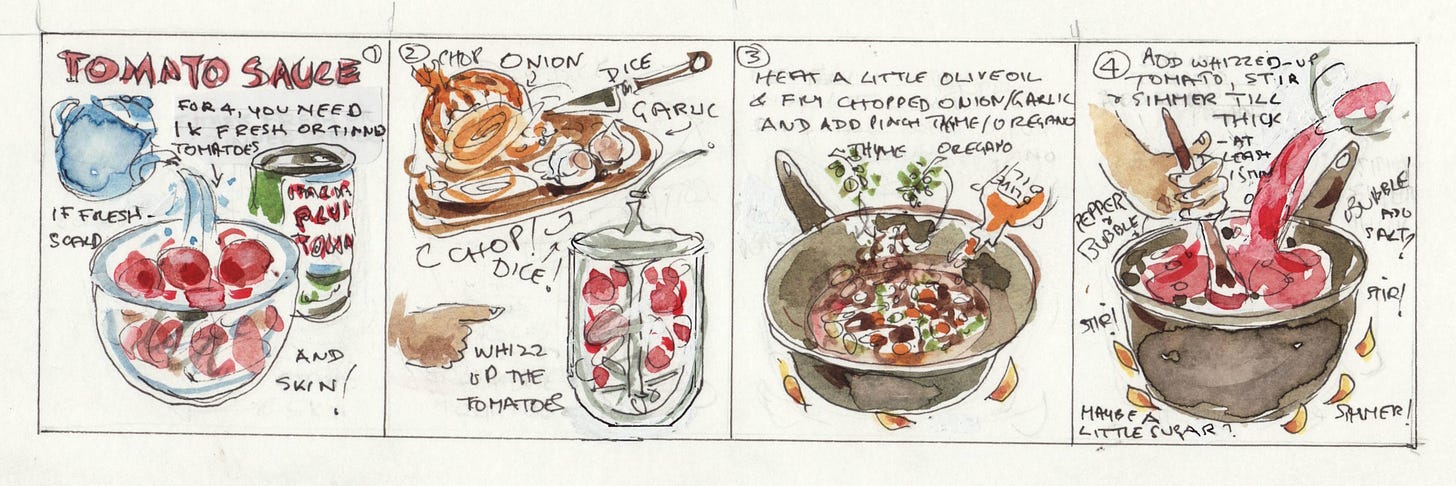
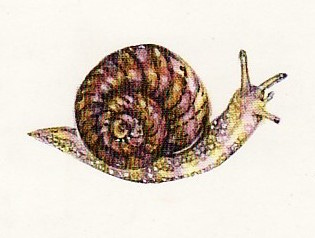

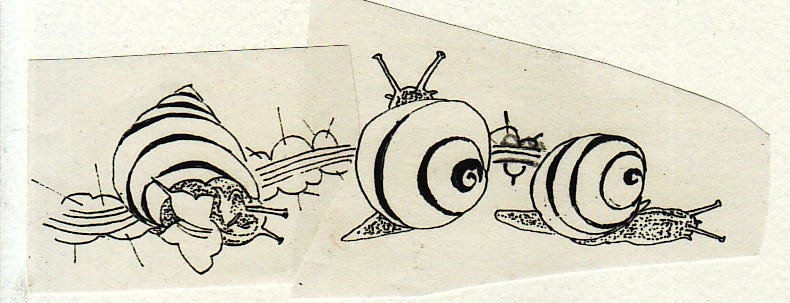
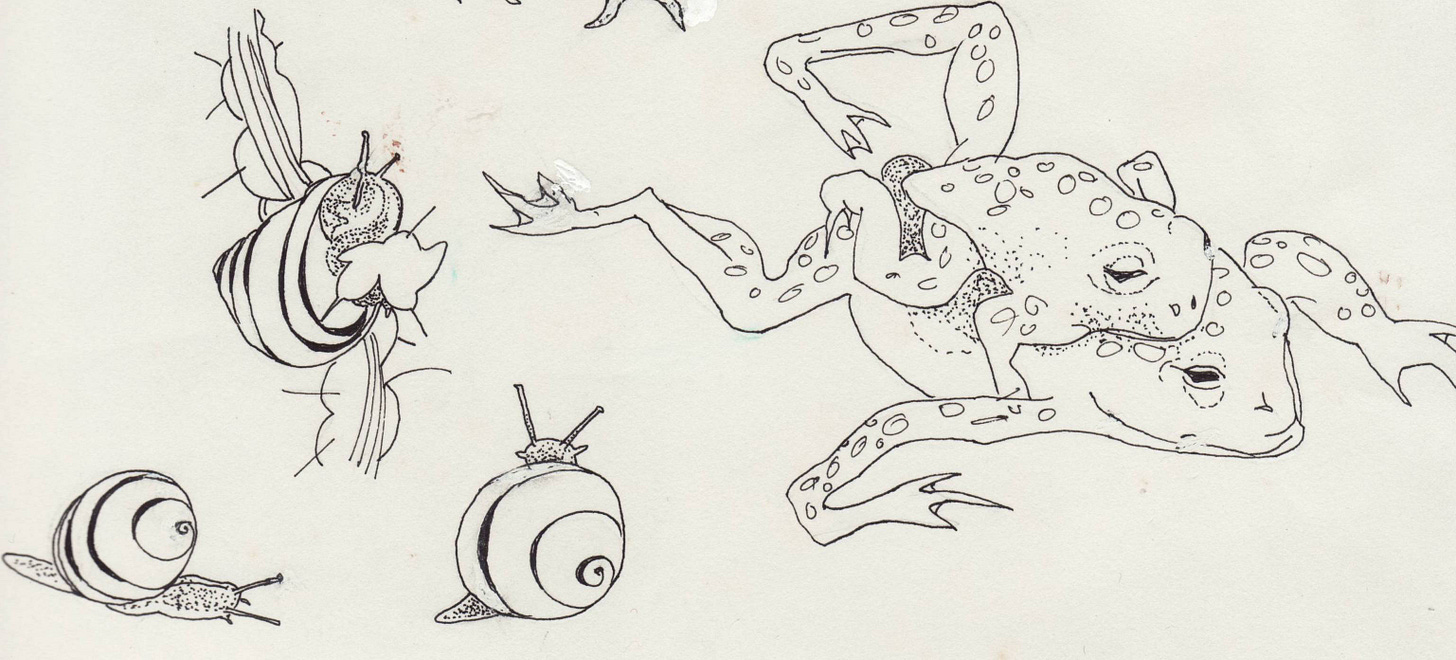
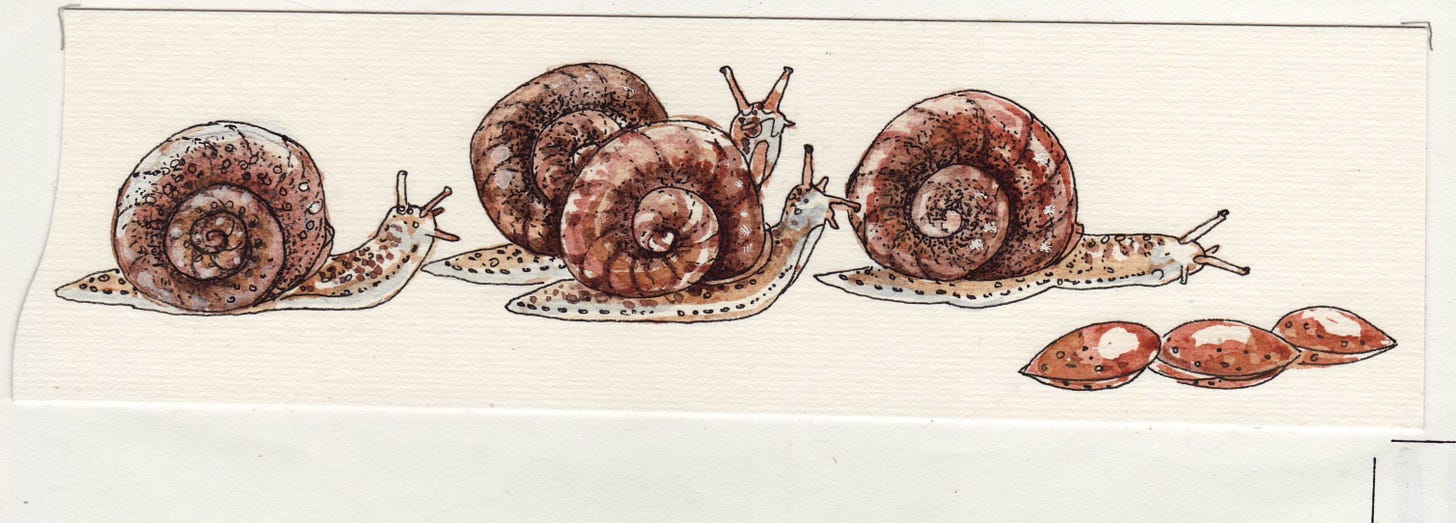



This is brilliant, Elisabeth! Snails…who knew? Well, you, obviously. Thank you so much for shining your light. Not only delicious, they appear to be absurdly nutritious, to boot. Right oh - this time next week, it’s snails for supper! 🐌🐌🐌🐌🐌
My grandfather prepared snails weekly in his Welsh kitchen up to the 1970s, purging them with cabbage leaves and oats. He was from the Forest of Dean, and kept a lot of his country ways despite a lifetime working on the docks, his mushroom hunting skills were impressive. I have vividly happy memories of 'helping' him with the snails and then eating them, it seemed like a much better use of cabbage than what my nan did on Sundays. Snail water was also much more acceptable as a tonic than cabbage water.